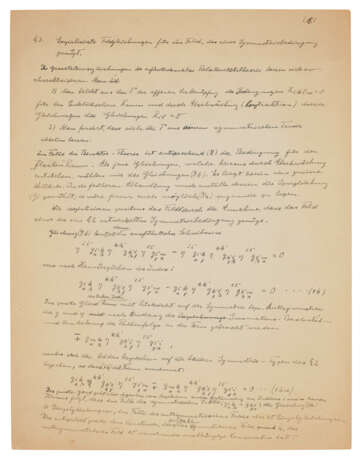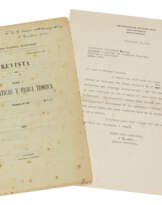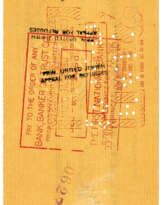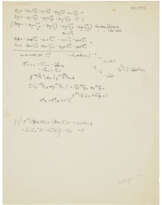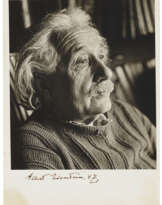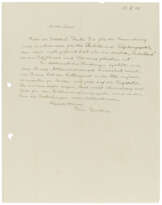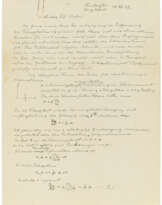ID 794556
Lot 71 | EINSTEIN, Albert (1879-1955)
Valeur estimée
£ 40 000 – 60 000
Autograph manuscript, section 3 of a paper on unified field theory, 'Spezialisierte Feldgleichungen für ein Feld, das einer Symmetriebedingung genügt' (Specialised field equations for a field satisfying a symmetry condition), n.p., n.d. [before 23 August 1943]
In German. One page, 277 x 214mm, including seven mathematical formulae, foliated '8' at upper right.
On the 'gravitational equations of the infinitesimal theory of relativity': the genesis of Einstein's final approach to unified field theory. An unpublished autograph draft relating to Einstein's work with mathematical bivectors: exceptionally rare in private hands.
The manuscript opens with a section number '3', and the sub-title 'Specialised field equations for a field satisfying a symmetry condition', and goes on:
The gravitational equations of the infinitesimal theory of relativity can be characterised as follows.
1). The conditions Riklw=0 for the Euclidean space are formed from the G of the affine linkage and the equations Ril=0 by weakening (extracting) these equations
2). It is required that the G can be derived from a symmetric tensor.
In the case of the bivector theory, (8) is the condition for the “flat” space. We choose equations (8b) as the equations which result from this by weakening. There is a certain arbitrariness in this. In the earlier paper, the trace equation (9) was chosen instead; it would also be possible to use (8a) as a basis.
Second, we specialise the field by assuming that the field satisfies one of the symmetry conditions developed in section 2...
Einstein goes on to retranscribe the field equation in two different ways, before proposing further permutations of two terms within the equation. He concludes that in a symmetrical field (whose formula he gives), 'the equation (16) has 6 individual equations, but in the case of the antisymmetric field it has 10 individual equations. This corresponds precisely to the fact that, according to section 2, the symmetrical field 6 and the antisymmetrical field 10 have components that are independent of one another'.
Einstein had submitted two articles on 'Bivector Fields' to Annals of Mathematics (received 23 August 1943, published in Second Series, Vol. 45, No. 1 (January 1944), pp. 1-14 and 15-23). These were his only papers on unified field theory to be published during World War II, and marked a decisive shift to the more purely mathematical approach to unified field theory which was to dominate his last years. Where previously he had concentrated on redefining the geometry and dimensions of the space-time continuum, Einstein explains in the introduction to the first article that he now proposes to retain the four-dimensional space-time continuum and general covariance of general relativity, but replace the Riemannian metric (the symmetric tensor gik) which defines the structure of the physical continuum with an approach based on bivectors: these view a field as a composite product of two vectors, and Einstein uses them to generate both the symmetric and antisymmetric cases of a 4 x 4 tensor matrix. In the introduction to the second article, Einstein suggests that his new theory 'shows marked analogies with that of the Riemannian metric', with the difference being that the new fundamental field variables, unlike the gik of Riemann, 'depend on the coordinates of two points'. The present article is a discarded draft for section 3 of the second paper, which shares its title but is itself much shorter and more focused in scope.
Special notice
This lot has been imported from outside of the UK for sale and placed under the Temporary Admission regime. Import VAT is payable at 5% on the hammer price. VAT at 20% will be added to the buyer’s premium but will not be shown separately on our invoice.
| Artiste: | Albert Einstein (1879 - 1955) |
|---|---|
| Lieu d'origine: | Europe de l'Ouest, Allemagne, Europe, Suisse |
| Catégorie maison de vente aux enchères: | Lettres, documents et manuscrits, Médecine et sciences |
| Artiste: | Albert Einstein (1879 - 1955) |
|---|---|
| Lieu d'origine: | Europe de l'Ouest, Allemagne, Europe, Suisse |
| Catégorie maison de vente aux enchères: | Lettres, documents et manuscrits, Médecine et sciences |
| Adresse de l'enchère |
CHRISTIE'S 8 King Street, St. James's SW1Y 6QT London Royaume-Uni | |
|---|---|---|
| Aperçu |
| |
| Téléphone | +44 (0)20 7839 9060 | |
| Commission | see on Website | |
| Conditions d'utilisation | Conditions d'utilisation |
